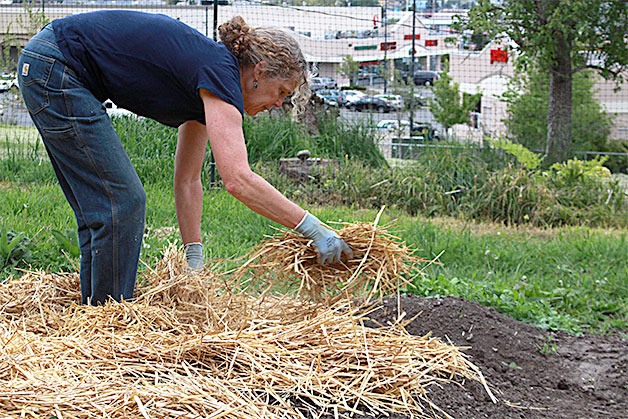As Oak Harbor history goes, the dirt underneath Karla Freund’s feet is essentially hallowed ground.
She works the garden on the hillside of the old Freund farmstead almost daily, getting a birds-eye view of Oak Harbor’s past and present.
Standing over rows of eggplant, cucumbers, radishes and beets, she can look beyond an 1860s farmhouse still on the property and see most of Oak Harbor’s cityscape and more modern development.
She can hear the sounds of progress, too, from the sirens to whizzing cars and horns that blare all too frequently at the nearby intersection of Erie Street and Highway 20.
“I hear a lot of ‘car wash!’” Freund said. “Once in a while, I think someone’s calling my name, ‘Kar-la!’”
 Remnants of Oak Harbor’s quiet, rural country charm of decades past are harder to find these days in a city that is celebrating its centennial anniversary this week.
Remnants of Oak Harbor’s quiet, rural country charm of decades past are harder to find these days in a city that is celebrating its centennial anniversary this week.
Founded in 1851 as one of Washington’s earliest white settlements, the city wasn’t incorporated until 1915.
Yet, it was an event a quarter century later that impacted Oak Harbor most, and literally altered the city’s landscape, with the arrival of Whidbey Island Naval Air Station, and the growth that ensued.
“It’s definitely grown,” said Carl Freund, Karla’s husband and the great-great nephew of Ulrich Freund, one of Oak Harbor’s founders.
“I’ve seen it grow up from almost nothing,” said Earle Darst, 96, a retired bulb farmer and descendent of an Oak Harbor pioneer. “I remember when it was a little town like Coupeville and then it grew up after the Navy came.”
Oak Harbor’s population hovered around 400 in the 1920s and 30s when boat travel was the only way to reach Whidbey Island.
Deception Pass bridge was opened in 1935, ending the reliance on ferries to get to and from the mainland.
A major shift in Oak Harbor’s rural landscape came in the early 1940s when the U.S. government purchased land from farmers near Crescent Harbor, Maylor Point and Clover Valley and began construction of a naval seaplane base and air field.
“That was the turning point in the history of Oak Harbor,” said Peggy Darst Townsdin, who wrote three books chronicling the city’s history.
“Harvey Hill, a historian in town, wrote that when the Navy came everyone was working and everybody had money in their pockets. There were jobs for everybody.”
Oak Harbor continued to maintain its small town character, however, for several decades, and in some respects, still does to this day.
Some of the city’s institutions such as the Kow Korner, Blue Fox Drive-In Theater and Roller Barn arrived on the scene in the 1950s.
The drive-in and roller rink still remain as family traditions while the Kow Korner lasted until the turn of the century.
Fast food chains started arriving in Oak Harbor in the 1970s.
Walmart came in 1998.
“My earliest recollections of Oak Harbor was this charming little farming community,” said Rick Castellano, executive director of the Island County Historic Society.
Castellano grew up in Port Townsend but spent time as a sales representative in Oak Harbor during his college years.
“It hadn’t changed much until McDonald’s came to town,” he said, referring to the mid 1970s. “That’s when it started becoming a city.”
Oak Harbor is currently a city of about 22,000 that still celebrates many longtime traditions and festivals from its Dutch and Irish heritage and makes it a point to recognize is connection to the Navy.
“One of the things where we’ve been very fortunate is we have a good relationship with the Navy that has been steadily growing,” said Al Koetje, an Oak Harbor native who was mayor of the city from 1972-96. “The city kind of grows with it. It’s very apparent that we appreciate having them as part of our community.”
Staying connected to its history also is important to Oak Harbor residents and business owners as is evidenced by the recent makeover of the city’s historic downtown and continued efforts to revitalize that part of town.
However, growth and development often won out over historic preservation in Oak Harbor as opposed to other communities on the island.
Carl Freund holds dear memories of the dairy farm his father and grandfather ran on the property where he grew up.
But, over time, portions of the farm that once covered 160 acres were sold, making way for commercial ventures like Walmart, Safeway, and Haggen.
Freund still jumps on a tractor and mows the grass regularly on part of the family’s remaining acreage while his wife tends to the garden.
The farmhouse his great-great-uncle, great-grandparents, grandparents and parents once lived in is hidden by an overgrown hedge and weeping willow that he remembers starting as a sucker from a giant that had fallen.
Ultimately, however, he sees what’s left of the farm on the hill disappearing. Some of the land is zoned for residences.
“It’s the economics of it,” Freund said. “It has to be developed.”
Open houses celebrate incorporation
The first in a series of special events planned to mark the centennial of Oak Harbor’s incorporation will be Thursday, exactly 100 year from the day when the little seaside community officially became a city.
The Oak Harbor Fire Department is holding an open house from 2 to 6 p.m.
The family-friendly event will include demonstrations, tours, a display of old-timey photos, water play for kids, safety information, refreshments and even door prizes, according to Angela Braunstein, the department’s administrative assistant.
She explained that series of open houses in city departments and other events are planned to occur throughout the year.
The firehouse open house is the first stop in a game of “centennial bingo” planned for the year of events, according to Braunstein.


